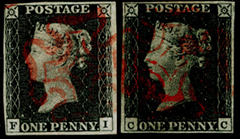 First Issues Collectors Club
of stamps and philatelic material
First Issues Collectors Club
of stamps and philatelic material
Home - Catalog - Categories - Index - Journal - Exhibits - Auctions - Forgeries - Join
 First Issues Collectors Club
of stamps and philatelic material
First Issues Collectors Club
of stamps and philatelic material
Home - Catalog - Categories - Index - Journal - Exhibits - Auctions - Forgeries - Join
| first issues > countries > scinde |
Imperforate, no watermark, embossed.
Embossed and printed by Thomas De La Rue and Co., London.
| Description | # printed | # issued | Scott # | S.G. # |
|---|---|---|---|---|
½ anna red |
? | ? | A3 | S3 |
½ anna white |
? | ? | A1 | S1 |
½ anna blue |
? | ? | A2 | S2 |
Forgeries are plentiful.
The Dawk, or Dak, was a very old postal system of runners. The runners were paid according to distance of travel and weight of the letter.
Sir Bartle Frere of the East India Company became the Chief Commissioner of Sind, also known as Scinde, in 1850. He improved upon the postal system of the state by introducing a cheap and uniform rate for postage, independent of distance traveled. In 1851 the runners were replaced with an efficient system using horses and camels, following routes through Scinde province, generally along the valley of the Indus river. The mail was carried quickly and efficiently, connecting government offices and post offices from Karachi through Kotri and Hyderabad up to Shikarpur in the north. The Scinde district is now a part of Pakistan.
These were the first stamps issued in Asia. They are also the worlds first round stamps.
One of the rarest classics of philately, the red ½ anna Scinde Dawk was issued first, on July 1, 1852. However, the stamps were not an unbridled success. The red sealing wax wafer stamps, embossed with a backing of paper, were so fragile that they easily cracked and disintegrated. Since they were often used as a seal on a letter, many were destroyed when the letter was opened.
The next attempt was a colorless embossing on whitish or bluish paper. Light blue lines were added between the stamps in the second printing. No one knows whether they were guidelines for separating the stamps or guidelines for the embossing. This version had its own problems. It was very difficult for the postal clerks to see at night by candlelight, especially when they were attached to white envelopes.
Finally, the blue stamps, made by simultaneous printing and embossing, were tried. These stamps are found in several shades of blue and they too are found with blue dividing lines between the stamps. This last version was issued shortly before the Scinde Dawks were withdrawn from use.
The location of production of these stamps is not known for sure. All we know is that the stamps were ordered from Thomas De La Rue and Company in London, and the embossing device manufactured by De La Rue. Some speculate that the red and white stamps were manufactured locally in India. However, most contemporary sources indicate that the stamps were produced in England.
These stamps were withdrawn on September 30, 1854, being replaced by the East India Company stamps. However, they are known used in June 1856. The remainders were soon after destroyed.
Thank you to Floyd Conaway for help with getting the facts straight.
| FI ref: 43 | Page credit: JA |
| Page created 19 Feb 2014 | Page updated 26 Jan 2016 |